Design and Aerodynamic Characteristics Analysis of an Electric Racecar Body Based on CFD
Abstract
:1. Introduction
2. Theoretical Basis and Control Equations
2.1. Theoretical Basis of Racecar Aerodynamics
2.2. Control Equation for Numerical Simulation
3. Design of the Electric Racecar Body
3.1. Design Method of Aerodynamic Characteristics and Rule Requirements on the Car Body
3.2. Principles for Body Selection and Overall Scheme Determination
3.3. Body Shape Design and Geometric Modeling
4. Simulation Analysis
4.1. Model Simplification
4.2. Computational Domain and Meshing
4.3. Simulation Solution Setup and Analysis
5. Manufacturing of the Racecar Body
5.1. Making of the Body Mold
5.2. Manufacturing of the Car Body Shell
6. Conclusions and Discussion
Author Contributions
Funding
Data Availability Statement
Conflicts of Interest
References
- China University Formula Automobile Race Rules Committee. The Third Edition of the Rules of the 2019 Chinese University Formula Competition; Automobile Engineering Society: Beijing, China, 2019. [Google Scholar]
- Xuan, Z.; Han, Z.H.; Zheng, F.Y.; Li, G. Design and Analysis of Aerodynamic Devices On FSC Racing Car. J. Liaoning Univ. Technol. 2015, 35, 308–312. [Google Scholar]
- Cheng, X.H.; Luo, S.M.; Chang, X.F.; Xie, D. Numerical Analysis of an External Flow-Field a-round a Formula SAE Car Body Based on FLUENT. Adv. Mater. Res. 2014, 1039, 17–24. [Google Scholar] [CrossRef]
- Lu, X. Research on the Flow Field Around a Formula SAE Car; Sae Technical Papers; Society of Automotive Engineers (SAE): Warrendale, PA, USA, 2015. [Google Scholar]
- Bai, Q.Y.; Wang, H.; Li, J.F.; Hao, X.F. Combinational design and analysis of aerodynamic devices of FSAE racing car. J. Hefei Univ. Technol. 2016, 39, 592–597. [Google Scholar]
- Yang, W.; Xie, R.X.; Cao, Z.H.; Meng, Y.J. Improving the Aerodynamic Package for a Formula SAE Race Car. J. China Sci. Pap. 2018, 13, 2050–2054. [Google Scholar]
- Yan, Z.Y.; Du, C.Q.; Hu, Y.F.; Wang, J.P. Study on aerodynamic performance of rear wing for Formula SAE racing cars based on finite element method. J. Chongqing Univ. 2019, 42, 29–39. [Google Scholar]
- Chao, Z.Y. Automotive Aerodynamics Simulation Technology; Peking University Press: Beijing, China, 2011; pp. 47–67. [Google Scholar]
- Nan, Q.; Ying, B.S.; Wu, J.J.; Yao, J.Y. Effect Study of Rear Diffuser on Aerodynamic Characteristics of Formula SAE Racing Car. Mach. Des. Manuf. 2019, 10, 72–79. [Google Scholar]
- Zhai, G.; Ren, C.; Tong, W. Design and optimization of inner-rotation nozzle in negative pressure duster. Adv. Mech. Eng. 2019, 11. [Google Scholar] [CrossRef]
- Zhang, Q.; Zhao, Y.Q.; Yang, G.Q. Overview of the development of numerical simulation of automobile external flow field based on CFD. Agric. Equip. Veh. Eng. 2005, 12, 8–11. [Google Scholar]
- Zhang, F.J.; Yang, L.; Wan, T.T.; Zhong, X.H.; Li, J.C.; Qiu, L.W. Research of FSE racing Car Aerodynamics Devices Based on CFD. Agric. Equip. Veh. Eng. 2019, 57, 54–57. [Google Scholar]
- Guo, Y.; Zhang, X.; Li, X.L.; Chao, H.; Li, X. Optimization design of Honda energy-saving racing car body. Highw. Automob. Appl. 2013, 6, 17–19. [Google Scholar]
- Available online: https://www.sohu.com/a/301721217_739408 (accessed on 16 March 2019).
- Abdul Latif, M.F.; Hashim, M.N.; Rashid, M.Z.A.; Azhari, M.A.; Othman, M.N. Roof Box Shape Streamline Adpatation and the Impact towards Fuel Consumption, MATEC Web of Conferences. In Proceedings of the Engineering Technology International Conference 2016 (ETIC 2016), Ho Chi Minh City, Vietnam, 5–6 August 2016. [Google Scholar]
- Luo, Y.; Feng, Y. Automotive Design; Machinery Industry Press: Beijing, China, 2011. [Google Scholar]
- Li, J.; Wang, D.; Tian, Y.; Pan, H. Lightweight Design of Hona Energy-Saving Racing SINGLE-Shell Body based on Carbon Fiber Material. J. Phys. Conf. Ser. 2020, 1622, 012113. [Google Scholar] [CrossRef]
- Qiu, C.W.; Yang, L.; Li, J.C.; Zhong, X.H. Design and verification of monocoque body of FSE electric racing car. Agric. Equip. Veh. Eng. 2019, 57, 22–26. [Google Scholar]
- Han, X.Q.; Wang, H.Y.; Hou, W.B. Design and CFD analysis of aerodynamics kit based on FSAE racing car. Exp. Sci. Technol. 2016, 14, 3–7. [Google Scholar]
- Wu, J.; Zhong, Z.H.; Gu, Z.Q. Further research on numerical simulation of automobile external flow field. Chin. J. Mech. Eng. 2003, 39, 110–113. [Google Scholar]
- Tan, J.F. The basic mechanics of high-speed cornering of a Formula One car. Eng. Phys. 1994, 1, 15–16. [Google Scholar]
- Katz, J.; Plotkin, A. Low Speed Aerodynamics; University of Cambridge: Cambridge, UK, 2002. [Google Scholar]
- Fu, L.M. Numerical Calculation of Automobile Aerodynamics; Beijing Institute of Technology Press: Beijing, China, 2001. [Google Scholar]
- Zhang, H.H. CFD analysis and optimization of aerodynamic characteristics of a car. J. Shaanxi Univ. Sci. Technol. 2002, 2, 70–73. [Google Scholar]
- Wang, F.J. Computational Fluid Dynamics Analysis; Tsinghua University Press: Beijing, China, 2005; pp. 120–121. [Google Scholar]
- Wang, F.L. Numerical simulation study on the influence of crosswind on car aerodynamic characteristics. J. Harbin Inst. Technol. 2006, 8, 75–77. [Google Scholar]

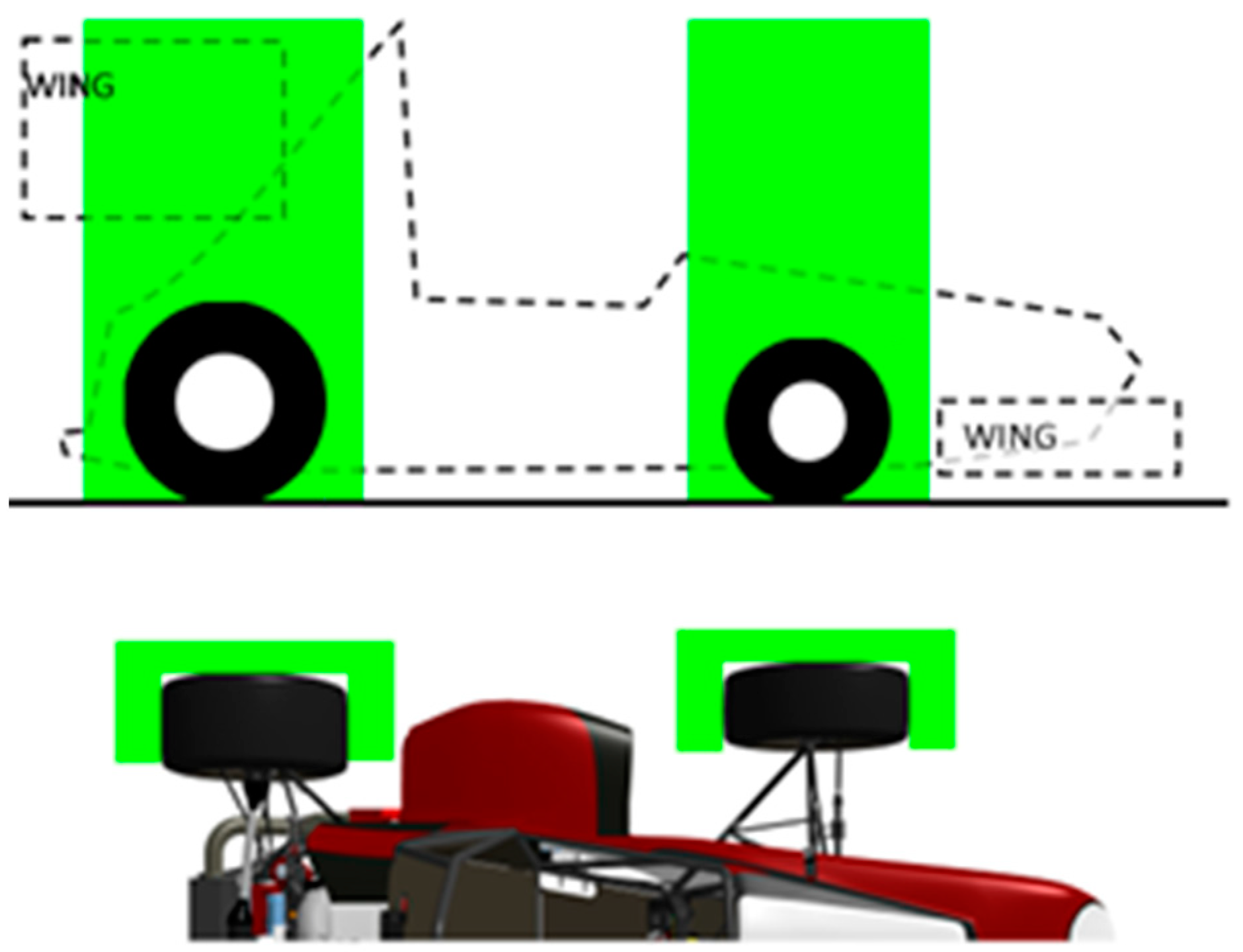
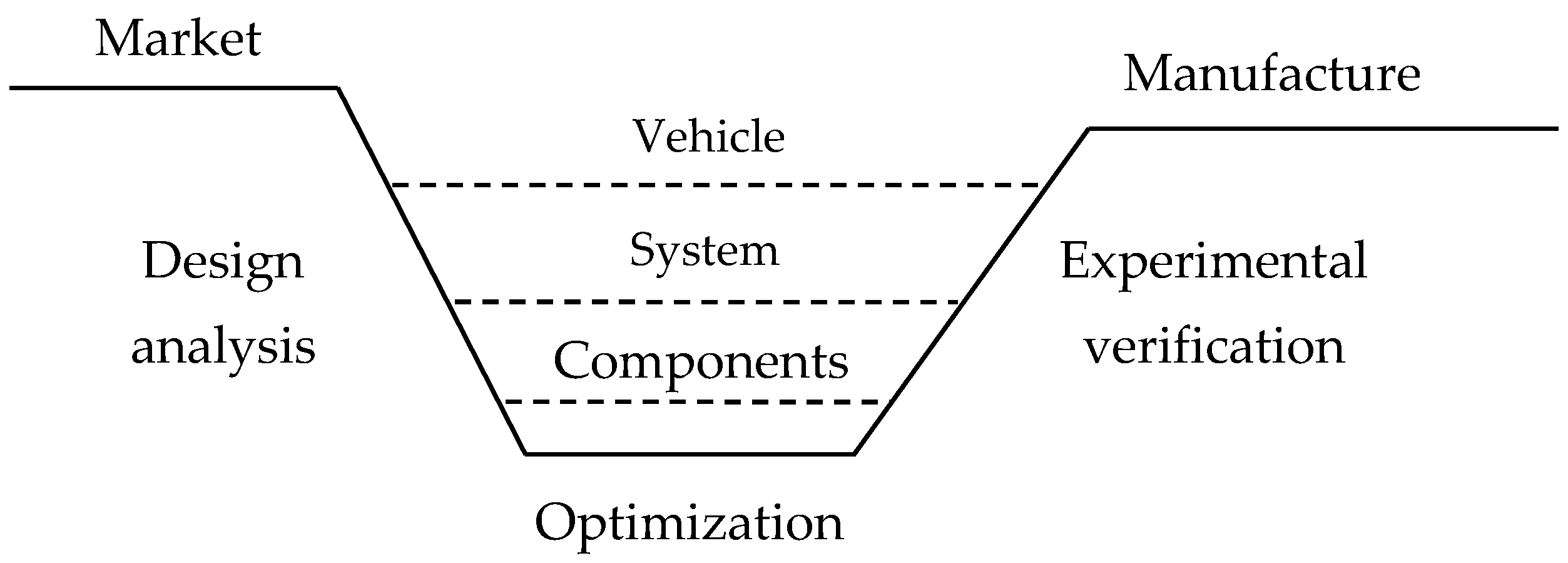

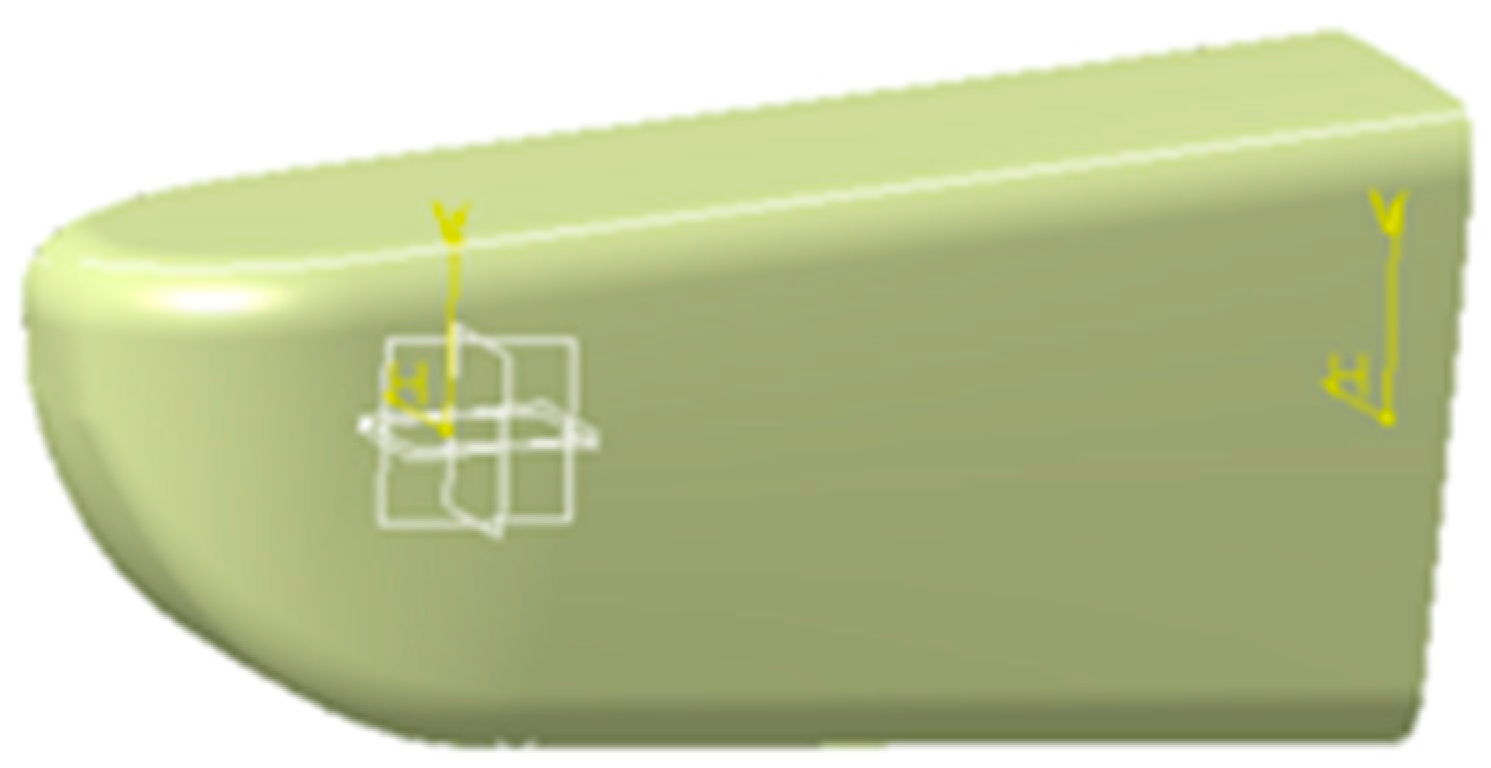
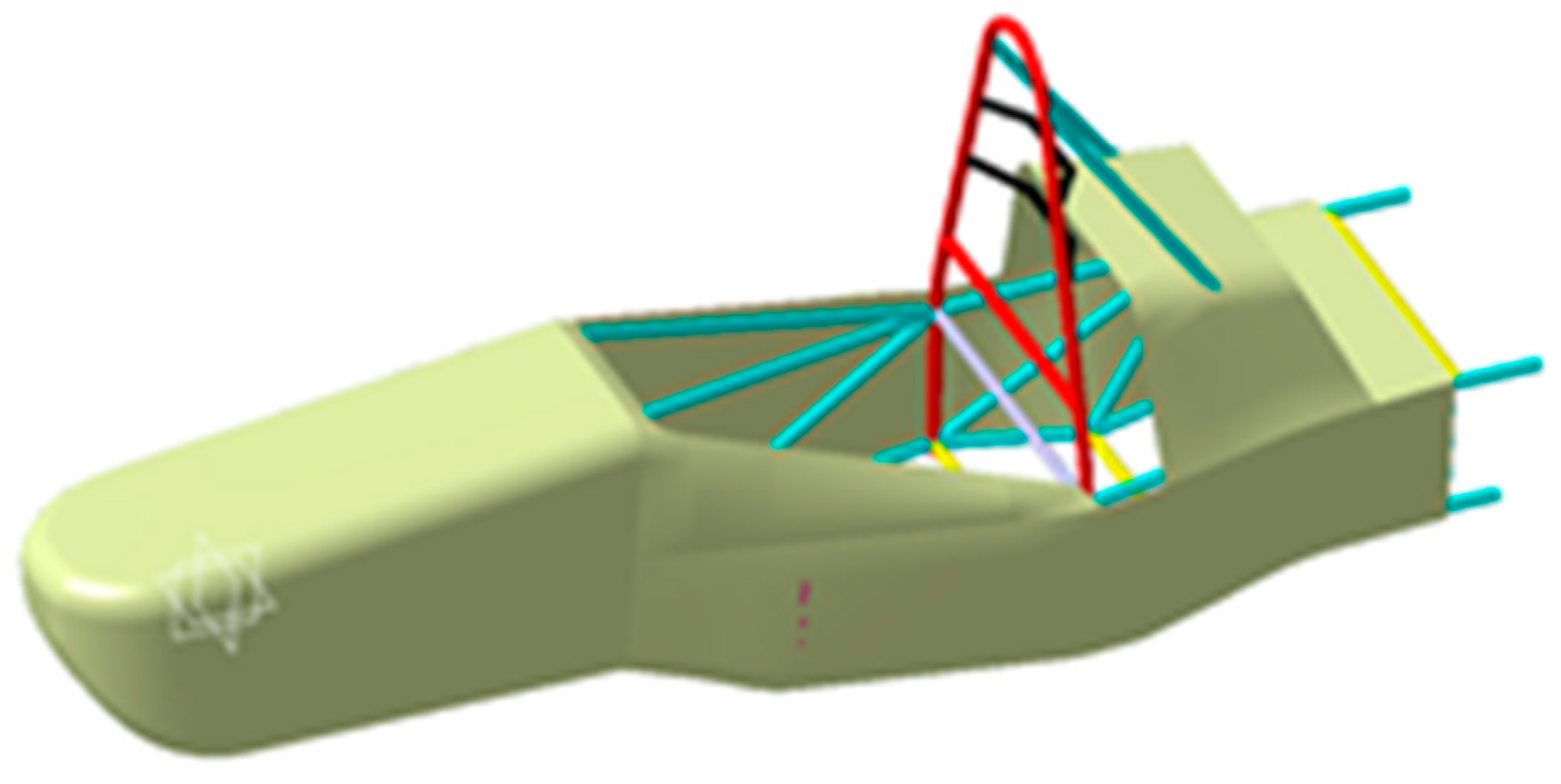


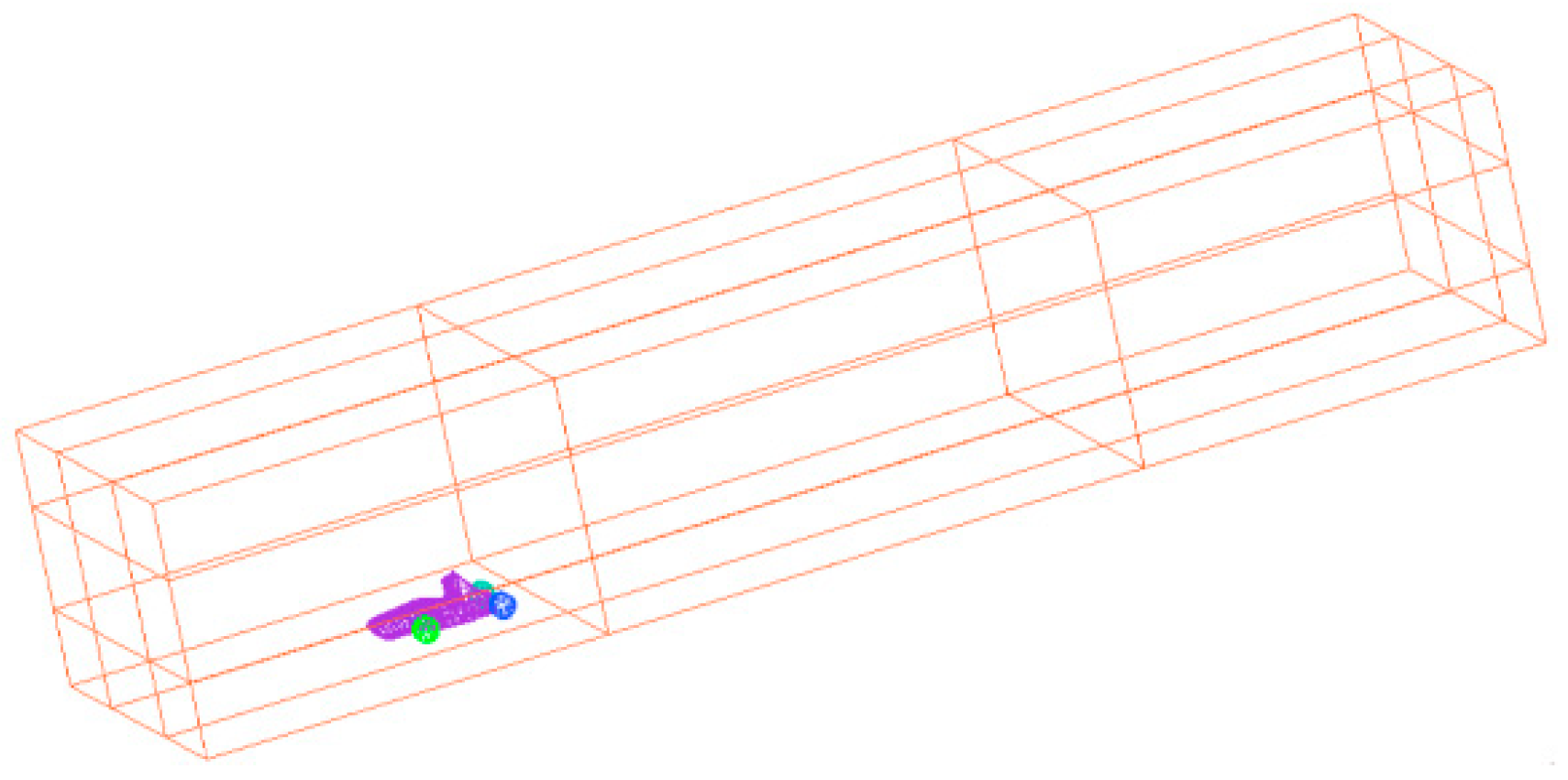
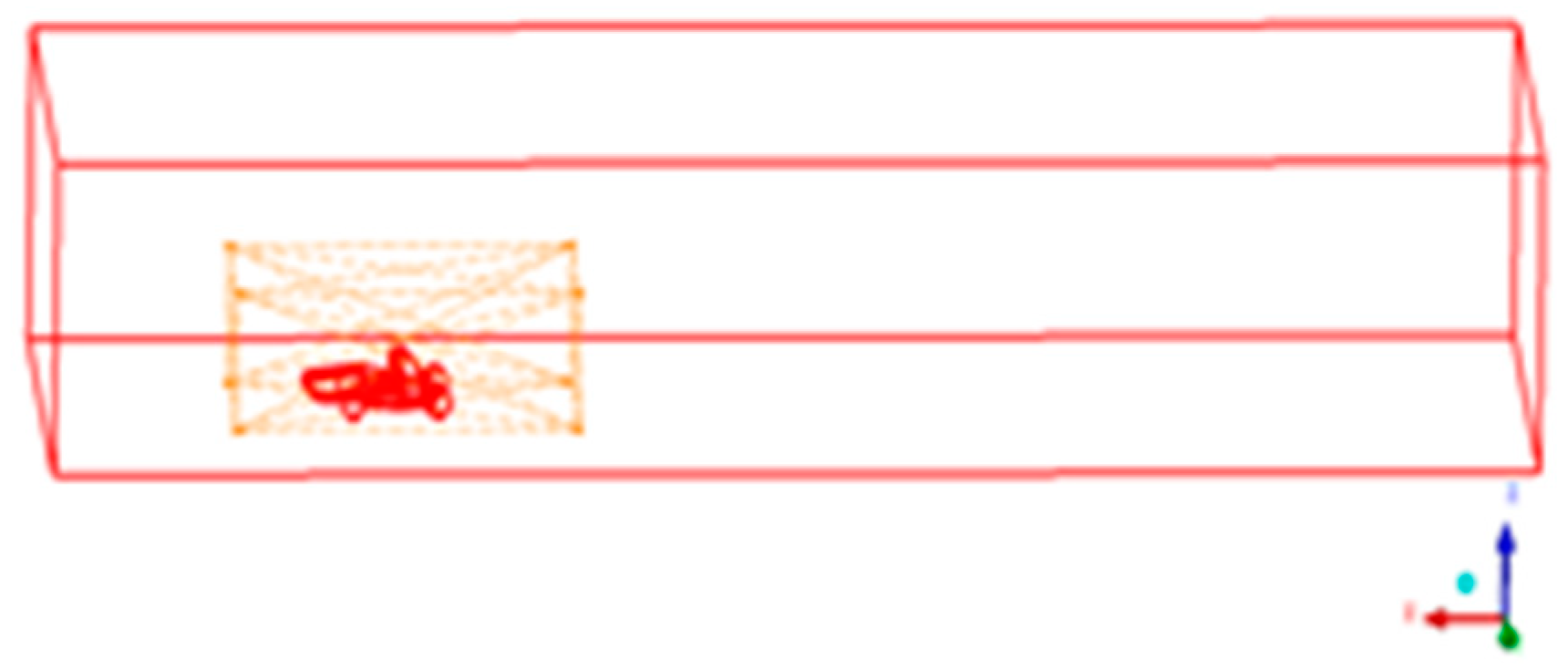
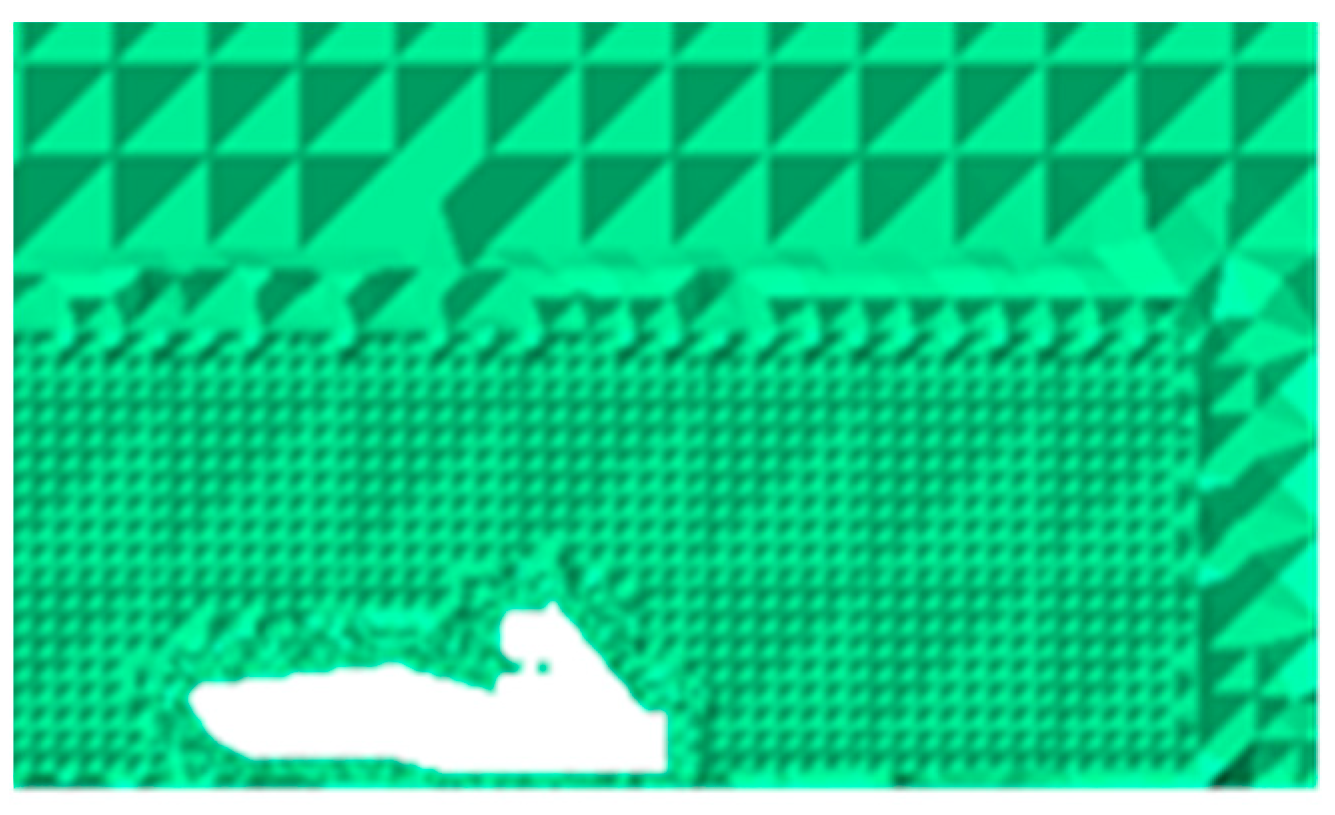
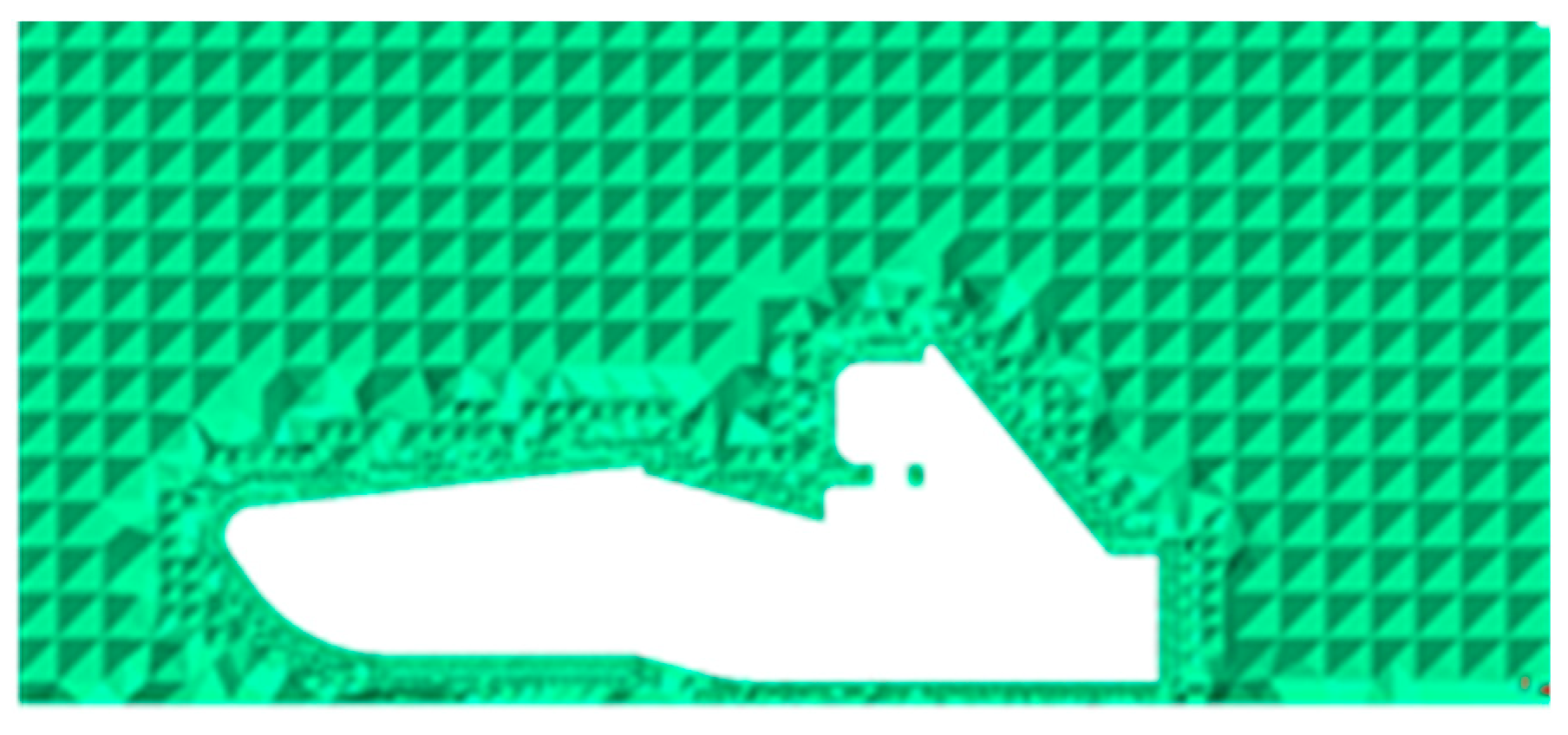
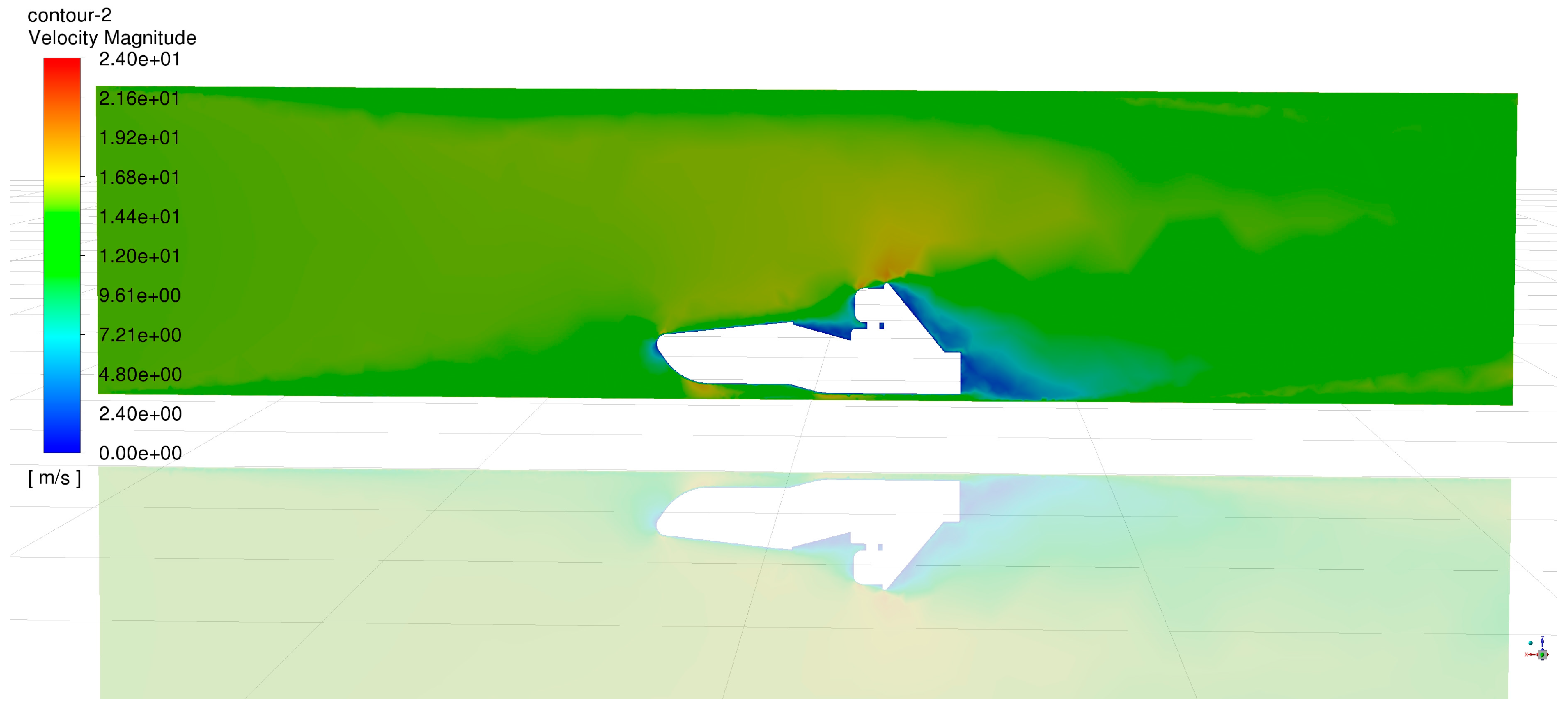
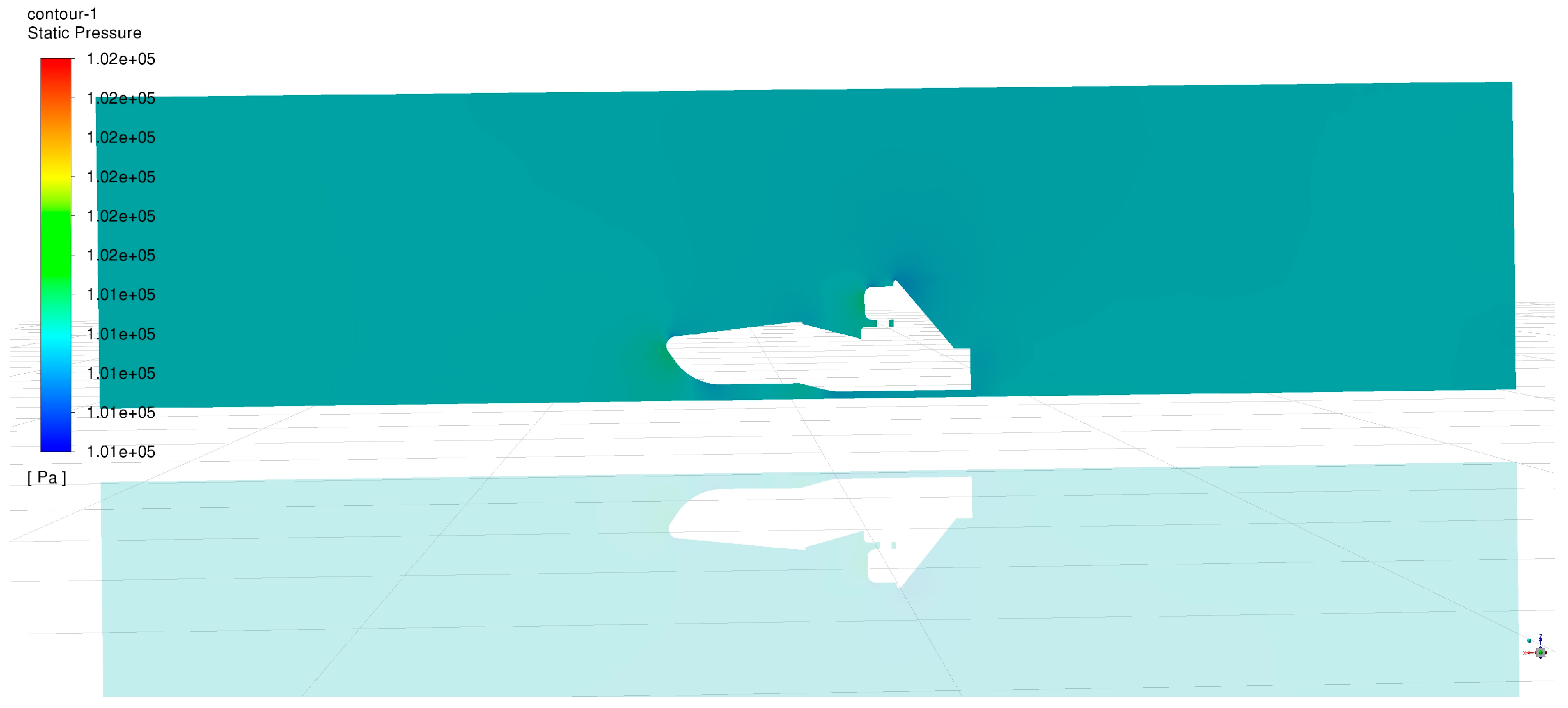


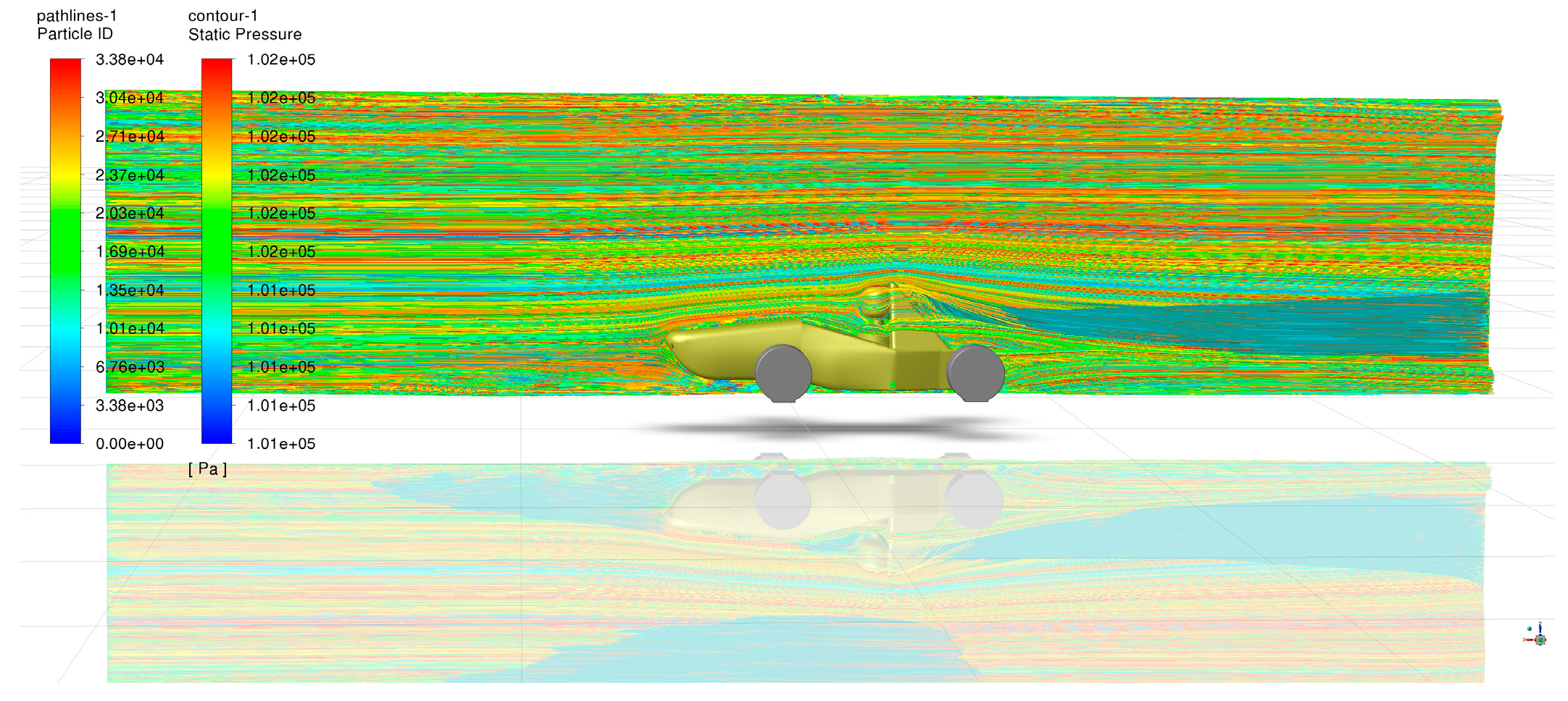
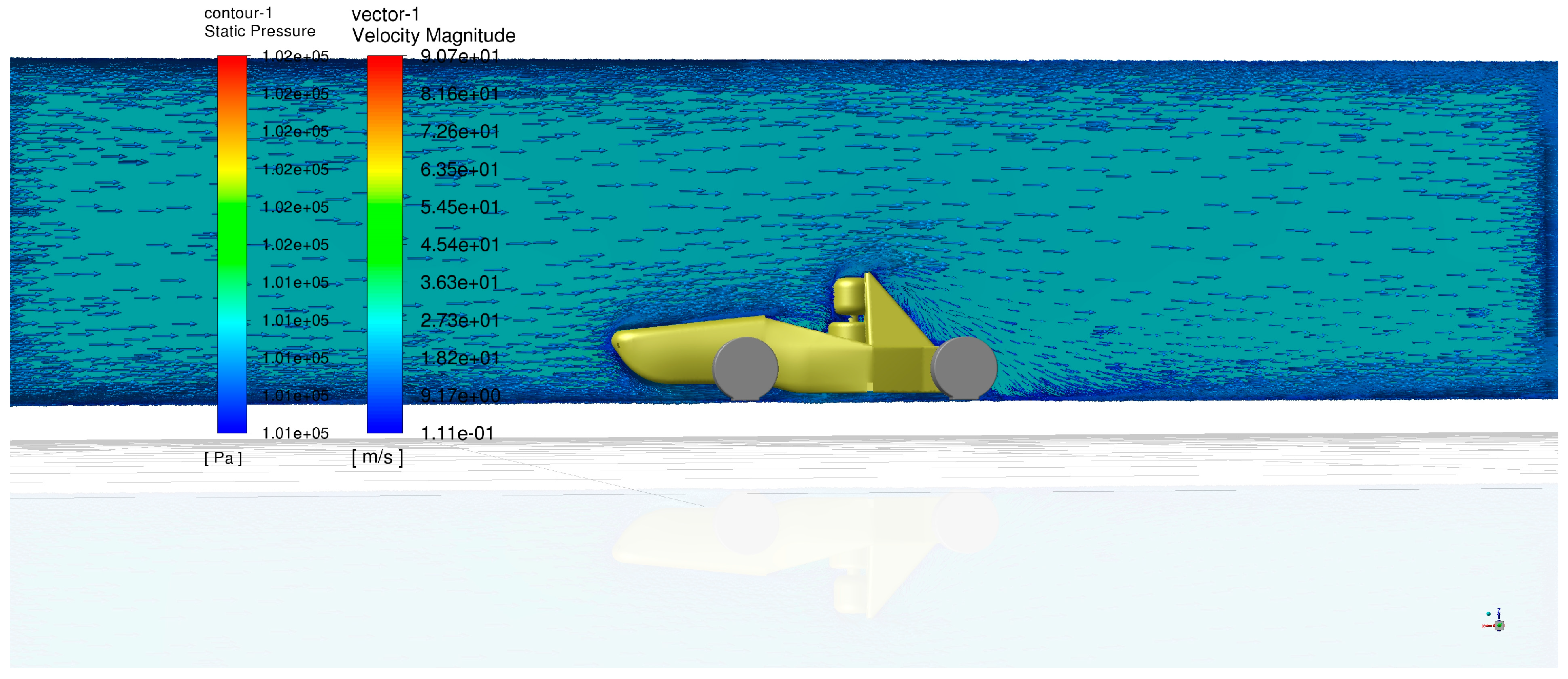
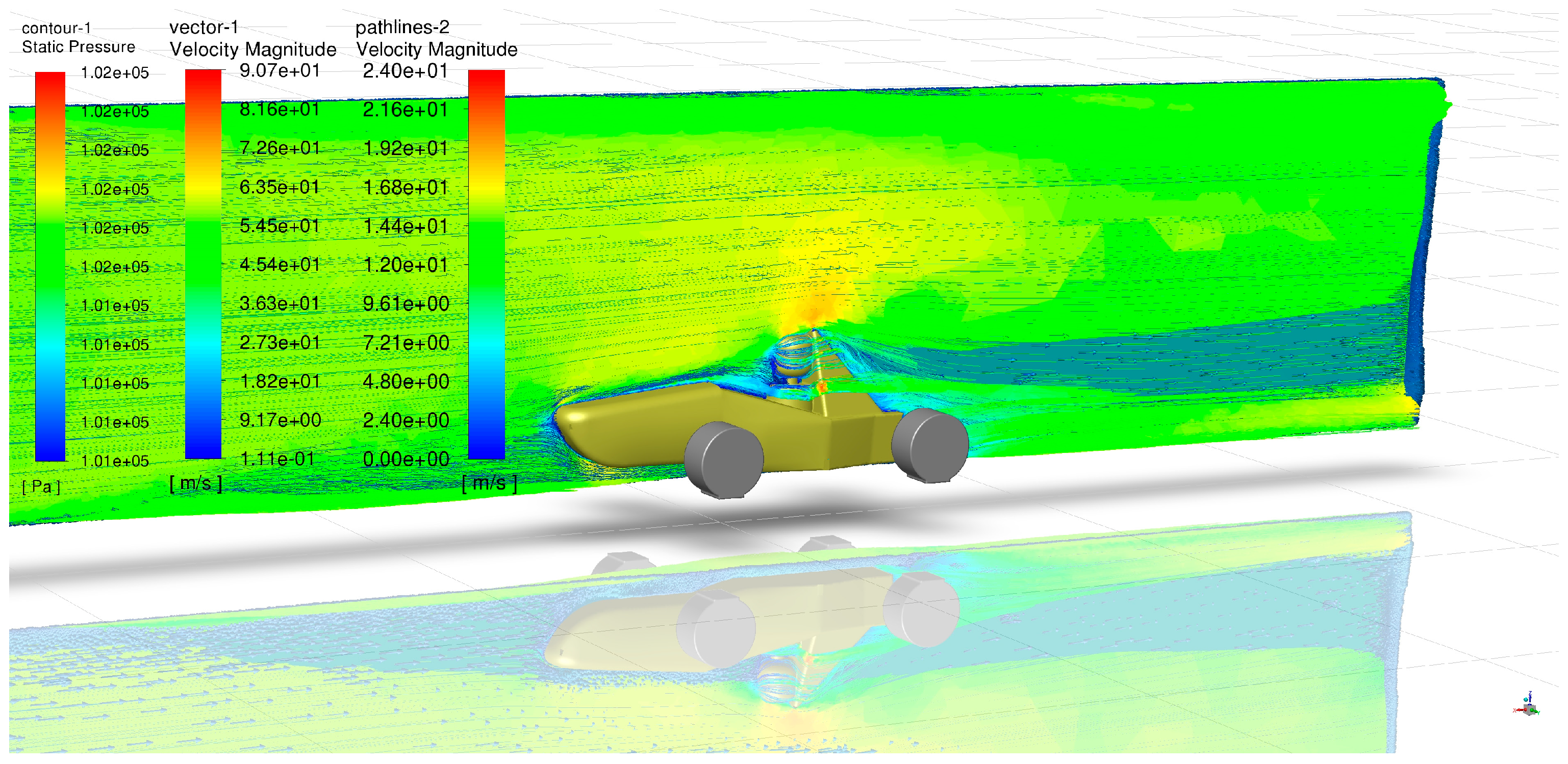

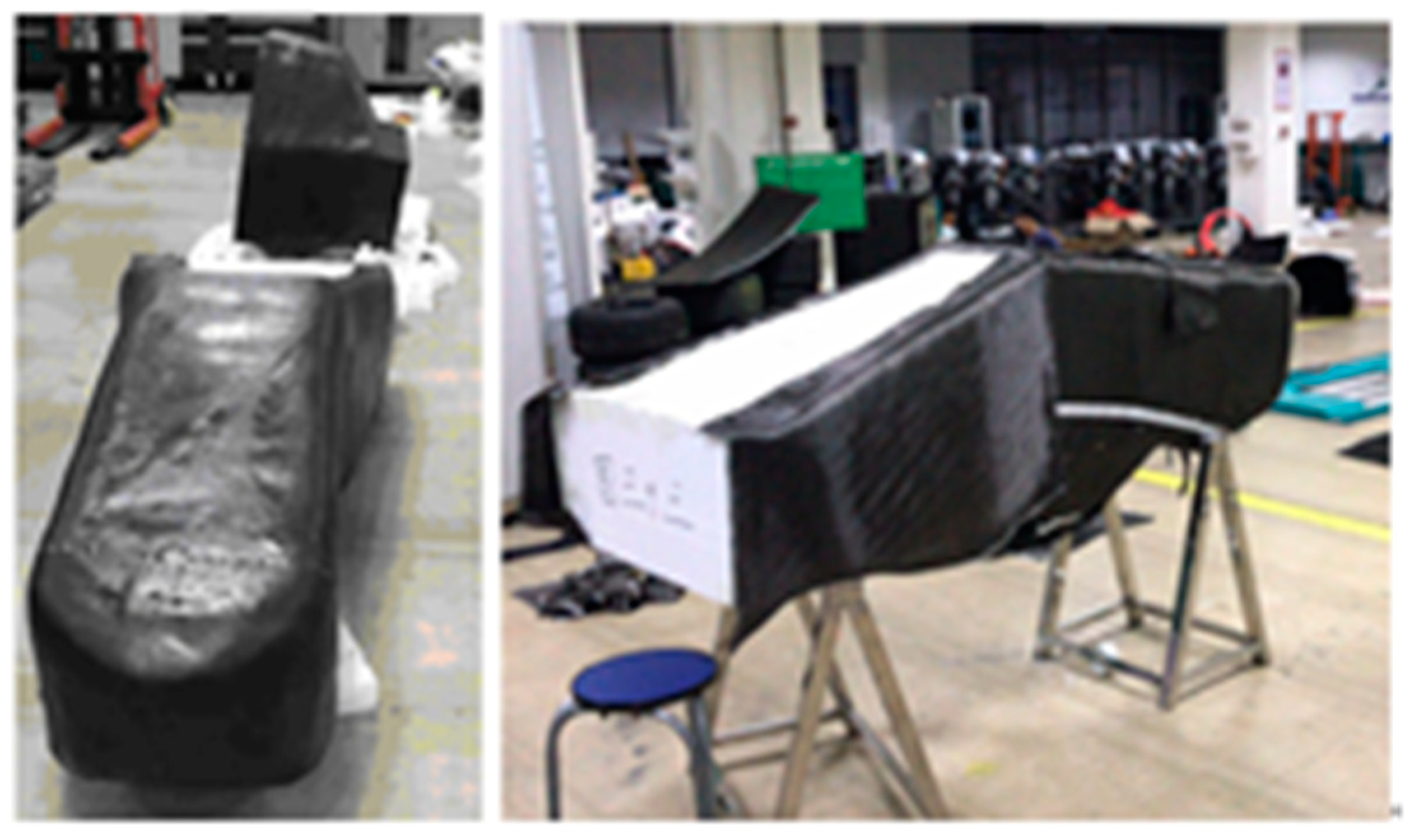
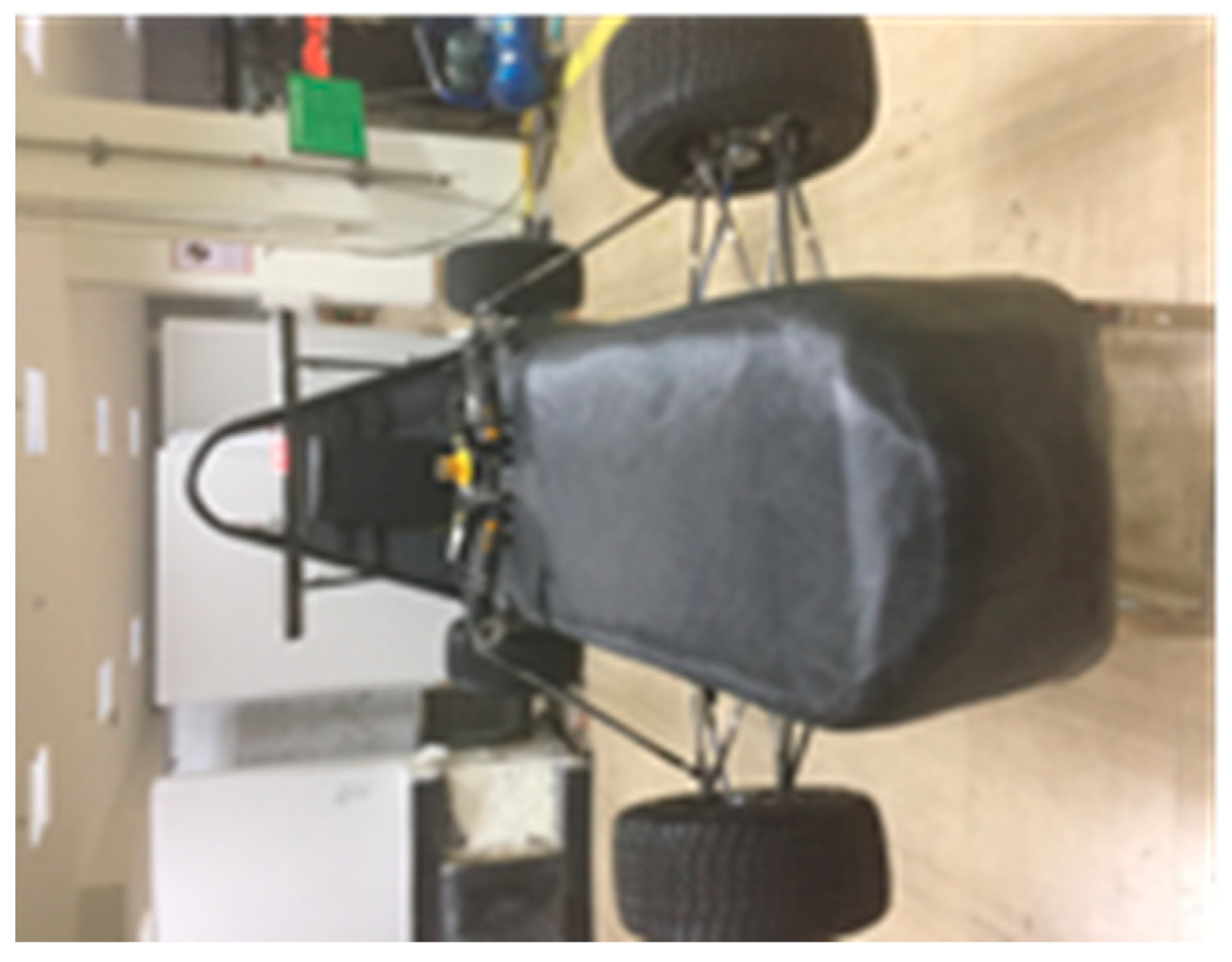
| Name | Sphere | Half- Sphere | Cone | Cube | Angled Cube | Long Cylinder | Short Cylinder | Streamlined Body | Streamlined Half-Body |
|---|---|---|---|---|---|---|---|---|---|
| Shape | ○ |  | △ | □ | ◇ |  |  |  |  |
| coefficient | 0.47 | 0.42 | 0.5 | 1.05 | 0.8 | 0.82 | 1.15 | 0.04 | 0.09 |
| Front Size | Rear Size | Total Width | Height | |
|---|---|---|---|---|
| Relative size | 2~3 times vehicle width length | 7~8 times vehicle width length | 3~4 times the vehicle width | 3~4 times vehicle height |
| Actual size | 6 m | 22 m | 8 m | 5 m |
| Aerodynamic Resistance (N) | Aerodynamic Lift (N) | |
|---|---|---|
| Previous generation body | 43.5 | 24.1 |
| Newly designed body | 30.5 | 20.5 |
| Comparison between two bodies | 13 | 3.6 |
Disclaimer/Publisher’s Note: The statements, opinions and data contained in all publications are solely those of the individual author(s) and contributor(s) and not of MDPI and/or the editor(s). MDPI and/or the editor(s) disclaim responsibility for any injury to people or property resulting from any ideas, methods, instructions or products referred to in the content. |
© 2024 by the authors. Licensee MDPI, Basel, Switzerland. This article is an open access article distributed under the terms and conditions of the Creative Commons Attribution (CC BY) license (https://creativecommons.org/licenses/by/4.0/).
Share and Cite
Li, J.; Liu, F.; Wang, L. Design and Aerodynamic Characteristics Analysis of an Electric Racecar Body Based on CFD. World Electr. Veh. J. 2024, 15, 192. https://doi.org/10.3390/wevj15050192
Li J, Liu F, Wang L. Design and Aerodynamic Characteristics Analysis of an Electric Racecar Body Based on CFD. World Electric Vehicle Journal. 2024; 15(5):192. https://doi.org/10.3390/wevj15050192
Chicago/Turabian StyleLi, Jixiong, Fengbi Liu, and Lei Wang. 2024. "Design and Aerodynamic Characteristics Analysis of an Electric Racecar Body Based on CFD" World Electric Vehicle Journal 15, no. 5: 192. https://doi.org/10.3390/wevj15050192






